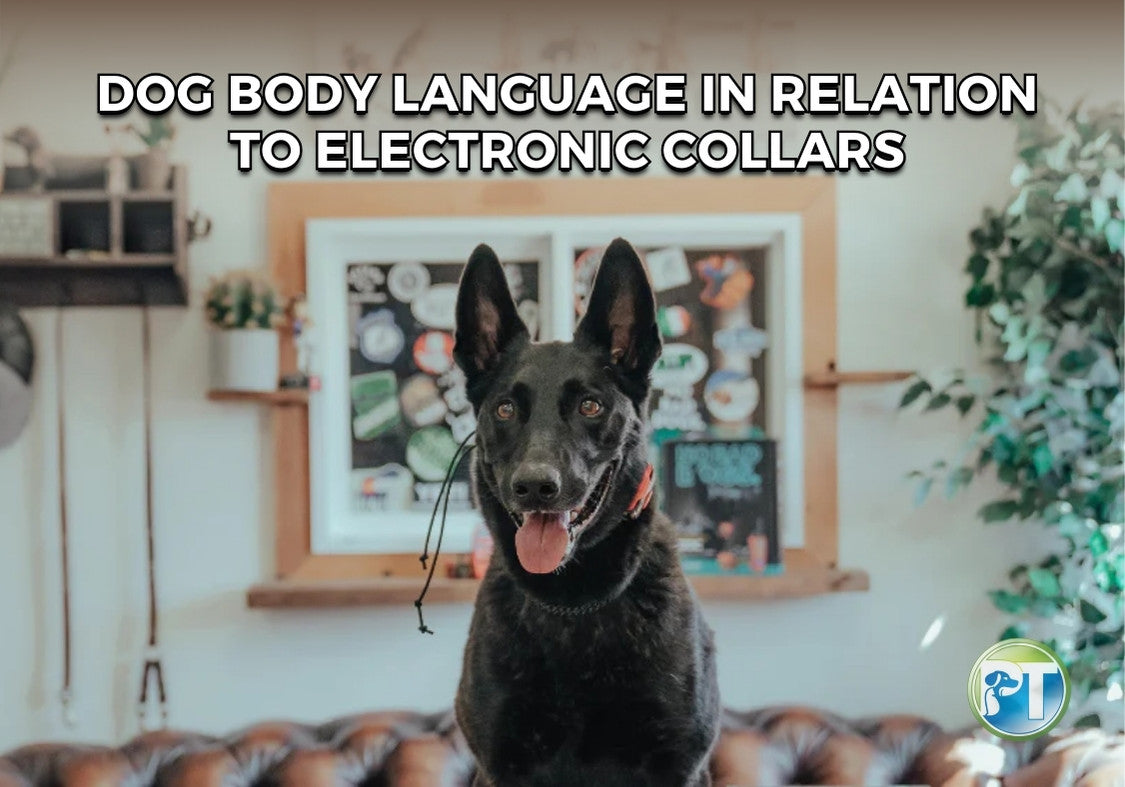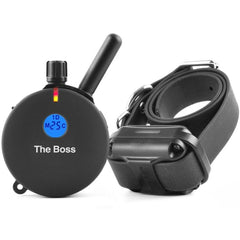Dog Body Language and E-Collar Training: How to Train Responsibly

Imagine trying to communicate with someone who doesn't speak your language. You would rely on their gestures, facial expressions, and body movements to understand them.
Dogs communicate in a similar way, using body language to express their feelings. As pet owners, it's essential to understand these silent cues, especially when using training tools like electronic collars.
The Basics of Dog Communication

Dogs communicate primarily through their body language. Every wag of the tail, tilt of the head, or shift in posture carries meaning. For instance, a dog with a wagging tail might be excited. However, if that tail is low and moving slowly, it could indicate uncertainty or fear. Similarly, a dog's eyes, ears, and overall stance can reveal whether they are relaxed, anxious, or ready to engage.
Understanding dog body language goes beyond just reading signs of happiness or discomfort. It is about interpreting the whole picture – how various signals work together to convey a dog's emotional state. For example, a dog that is relaxed and content will exhibit loose, fluid movements, a wagging tail, and a calm expression. In contrast, a dog that is stressed or fearful might have a stiff body with a tucked tail and avoid eye contact. Learning to read these cues can help you better respond to your dog's needs and adjust your training approach.
Introduction to E-Collar Training

Electronic collars, also known as e-collars or shock collars, are used in dog training to reinforce commands and correct undesirable behavior. These devices function by delivering a mild electric stimulation, vibration, or beep to capture the dog's attention. While they can be effective in specific training scenarios, they are often misunderstood.
One common misconception about shock collars is that they are harmful or cruel. However, when used correctly and responsibly, they can be a valuable tool in training. The key is to ensure that the collar is used at the appropriate intensity and timing. Additionally, e-collar training should be paired with positive reinforcement techniques to encourage desired behavior.
Another misunderstanding is that e collars for dogs are a quick fix for behavior problems. In reality, they should be part of a broader training program that includes consistency, patience, and understanding your dog’s needs.
Common Stress Signals in Dogs
When training your dog, it's crucial to recognize signs of stress. Stress can negatively impact your dog's learning and responsiveness. Here are common indicators of stress in dogs and how to identify them:
A. Signs of Stress in Dogs
1. Lip Licking and Yawning
When a dog licks its lips or yawns frequently, it’s often a sign of stress. This behavior can indicate that your dog is feeling anxious or uncomfortable. Lip licking and yawning are ways your dog tries to calm itself down.
2. Panting and Pacing
Excessive panting and pacing back and forth can be stress-related. These actions might release nervous energy. Pay close attention to these behaviors during training sessions, especially if they appear suddenly.
3. Avoidance Behaviors
A stressed dog may try to escape uncomfortable situations. This can manifest as turning away, hiding, or retreating. For instance, if your dog averts its head or moves away, it might feel overwhelmed. Avoidance is a clear indicator that your dog needs a break.
4. Trembling or Shaking
Trembling or shaking often occurs when a dog feels threatened or trapped. If you observe these behaviors, it's essential to pause the training session and provide comfort for your dog.
B. The Impact of Stress on Training
Stress can hinder your dog's ability to focus and learn. When stressed, dogs may struggle to follow commands or exhibit unpredictable behavior. This is because stress impairs their ability to think clearly. Training sessions that cause excessive stress can also damage the bond between you and your dog.
Dog Body Language During E Collar Training
When using an e-collar for training, it’s essential to watch your dog’s body language. This will help you understand how your dog is feeling and if the training is effective. Here’s how to recognize positive and negative indicators during training:
A. Positive Indicators

1. Signs Your Dog is Comfortable with Training
A dog at ease during training will exhibit a relaxed body posture. Their muscles will be loose, and their movements natural. A wagging tail is another positive sign, particularly when held in a neutral or slightly elevated position. This suggests your dog is content and confident. Additionally, if your dog maintains focus on you, attentively following your commands, it indicates engagement and readiness to learn.
2. Responsiveness to Commands
If your dog responds quickly and accurately to commands, it’s a sign that the training is going well. Your dog should look at you when you give a command and then perform the action without hesitation. This shows that your dog understands what you want and is willing to follow your lead. Consistent responsiveness indicates that your dog is comfortable with the training process.
3. Signs of a Good Training Session
A productive training session is characterized by a calm and focused dog throughout. Your dog should display interest in the activities and eagerness to participate. Post-session, your dog should maintain a relaxed body and a wagging tail. These signs imply effective and enjoyable training for your dog.
B. Negative Indicators

1. Signs of Discomfort or Fear
If your dog's tail is tucked between their legs during training, they may be experiencing fear or discomfort. Moreover, if your dog flinches, yelps, or avoids eye contact when stimulated by the e-collar, the intensity might be too high. These reactions are signs that the stimulation level is causing discomfort.
2. Signs Your Dog May Be Overwhelmed
Avoidance behaviors, such as trying to leave the training area or hiding, can indicate that your dog is overwhelmed. Excessive yawning or panting during training also suggests high levels of stress. Additionally, if your dog’s body language becomes more subdued or frantic, it may be a sign of overstimulation.
If you observe any negative body language during training, it is crucial to stop immediately. Allow your dog a break to relax and consider lowering the stimulation level on the electronic collar.
Adjusting E Collar Dog Training Based on Canine Body Language
Here’s how you can tailor the training to your dog’s needs:
A. Tailoring the Intensity of Stimulation

Always adjust the e-collar's intensity to match your dog's sensitivity. Begin with the lowest setting and closely observe your dog's reaction. Then, gradually increase the intensity until your dog responds to the stimulation without showing stress. If they exhibit signs of discomfort, such as flinching, yelping, or appearing anxious, the intensity is too high.
The goal is to use only enough stimulation to capture your dog's attention, not to cause pain or fear. Remember, every dog is unique, so carefully determine the appropriate level for your pet.
- Signs You've Found the Right Stimulation Level for Your Dog
When using an e-collar for dog training, it's crucial to ensure the stimulation level is appropriate. Here are the key body language signals that indicate you’ve found the perfect intensity level for your dog:
- Subtle head turn
- Slight ear twitch or perk
- Momentary pause in movement
- Quick glance toward the handler
- Neutral or slightly wagging tail
- Increased alertness or attention
- Focused response to commands
B. Timing and Duration of Training Sessions

Short, positive training sessions are more effective than long, stressful ones. Aim for sessions lasting 10-15 minutes, focusing on a few commands or behaviors during each session. Maintain a positive atmosphere and conclude the session before your dog becomes tired or frustrated. Frequent, brief sessions enhance learning and make training enjoyable.
C. Incorporating Positive Reinforcement

To optimize the effectiveness of dog e collar training, combine it with positive reinforcement. Reward your dog when they correctly follow a command. Rewards can include treats, praise, or playtime.
For instance, if your dog responds well to the collar's signal, immediately provide a treat or praise. This helps your dog understand that good behavior leads to positive outcomes. Eventually, your dog will begin responding to commands without relying on the collar or rewards.
Best E Collar for Dogs
In this section, we’ll explore some of the top e-collar options available, focusing on their features and benefits.
1. Dogtra 1900S
The Dogtra 1900S is known for its versatility and durability. Whether for obedience, competition, or K9 training, this e collar is dependable, with 127 levels of stimulation. Great for dogs 35 pounds and larger, this training collar for dogs has a 3/4-mile radius and is fully waterproof. It also comes in a camo and black finish.
2. ET-300 Mini Educator by E-Collar Technologies
The ET-300 Mini Educator is a favorite among dog owners and trainers. It has a ½-mile range and 100 levels of static stimulation. It also comes with a tone and vibration, ideal for sensitive and hearing-impaired dogs. This shock collar is fully waterproof and rechargeable, also available in black and Educator Zen 300 variants.
3. ET-800 Boss Educator by E-Collar Technologies
The Boss Educator ET-800 is designed for large and stubborn dogs. It has a 1-mile range, 100 levels of static, and 60 levels of boost. This e collar also comes with tone and vibration for sensitive canines. It’s a waterproof collar, recommended for dogs 20 pounds and larger.
4. SportDOG SD-425X FieldTrainer
Built for basic training and hunting, the SD-425X FieldTrainer is the smallest shock collar by SportDOG. It has a 500-yard range, 21 static levels, and other training options, including tone and vibration. This is an expandable trainer for up to 3 dogs.
5. Dogtra 200NCPT PetsTEK Edition

The Dogtra 200NCPT PetsTEK Edition is an excellent choice for small to medium dogs. It has a ½-mile range, 100 stimulation levels, an audible tone, and non-stimulating vibration. Best for dogs as small as 12 pounds, it’s an e collar for basic obedience lessons and off-leash training.
Bonus Tip
If you're unsure about using an electronic collar, consulting with a professional dog trainer is advisable. A qualified trainer can help you determine the best approach for your dog's training, whether or not it involves an electronic collar. They can provide guidance on appropriate tool usage and create a training plan tailored to your dog's needs.
Conclusion
Responsible dog training means putting your dog’s well-being first. Whether you opt for an e collar or another approach, always prioritize your dog's comfort and confidence. After all, training should be a positive experience that strengthens your bond.
-
Posted in
E-Collar Info & Guides, Training Tips






